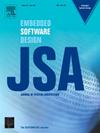DELTA: Deadline aware energy and latency-optimized task offloading and resource allocation in GPU-enabled, PiM-enabled distributed heterogeneous MEC architecture
IF 3.7
2区 计算机科学
Q1 COMPUTER SCIENCE, HARDWARE & ARCHITECTURE
引用次数: 0
Abstract
The use of Multi-access Edge Computing (MEC) technology holds great potential for supporting modern, computation-intensive, and time-sensitive applications. These applications are mainly generated from resource-constrained handheld or mobile user equipment (UE). As these devices have limited resources and some are also energy-constrained, it is crucial to offload some portions of the applications (or tasks) to the connected MEC servers. However, MEC servers also have limited resources compared to cloud servers, making it imperative to implement efficient task-offloading policies for UE devices and optimal resource allocation policies for MEC servers. In this paper, we first formulate the energy and latency minimization problem as a multi-objective Mixed Integer Programming (MIP) problem, and we propose a novel deadline-aware energy and latency-optimized task offloading and resource allocation (DELTA) strategy to execute the applications on a cooperative heterogeneous MEC architecture efficiently. Our policy aims to minimize the energy consumption of UEs and the latency of applications while meeting the deadline and dependency constraints of the applications. In our heterogeneous cooperative MEC system, as a novel contribution, we consider that the MEC servers are equipped with graphics processing unit (GPUs), solid-state disk (SSD) storage, and processing in-memory (PiM) enabled memory, in addition to the traditional processors, memories, and hard disk storage. Furthermore, we consider the UEs to be dynamic voltage and frequency scaling (DVFS) enabled. We perform an extensive simulation using the real data set on a standard simulator and compare our results with three different policies (Intelligent-TO (Chen et al., 2023), Multi-user (Yang et al., 2020) and Selective-random). Our proposed strategy DELTA achieves a 71.18% reduction in latency on average compared to the considered state-of-the-art policy, and it outperforms the most efficient benchmarked strategy, Intelligent-TO, by 59.6% in terms of latency. Regarding energy consumption for UE devices, the considered state-of-the-art policies consume about 4x more energy on average than the DELTA. Although Intelligent-TO is the most energy-efficient policy among those benchmarked, DELTA surpasses it, achieving a 59.6% reduction in energy consumption.
求助全文
约1分钟内获得全文
求助全文
来源期刊

Journal of Systems Architecture
工程技术-计算机:硬件
CiteScore
8.70
自引率
15.60%
发文量
226
审稿时长
46 days
期刊介绍:
The Journal of Systems Architecture: Embedded Software Design (JSA) is a journal covering all design and architectural aspects related to embedded systems and software. It ranges from the microarchitecture level via the system software level up to the application-specific architecture level. Aspects such as real-time systems, operating systems, FPGA programming, programming languages, communications (limited to analysis and the software stack), mobile systems, parallel and distributed architectures as well as additional subjects in the computer and system architecture area will fall within the scope of this journal. Technology will not be a main focus, but its use and relevance to particular designs will be. Case studies are welcome but must contribute more than just a design for a particular piece of software.
Design automation of such systems including methodologies, techniques and tools for their design as well as novel designs of software components fall within the scope of this journal. Novel applications that use embedded systems are also central in this journal. While hardware is not a part of this journal hardware/software co-design methods that consider interplay between software and hardware components with and emphasis on software are also relevant here.
 求助内容:
求助内容: 应助结果提醒方式:
应助结果提醒方式:


